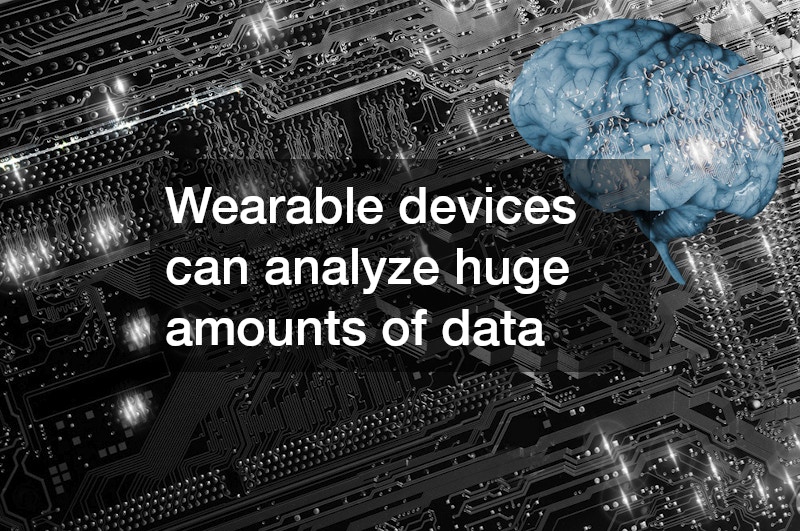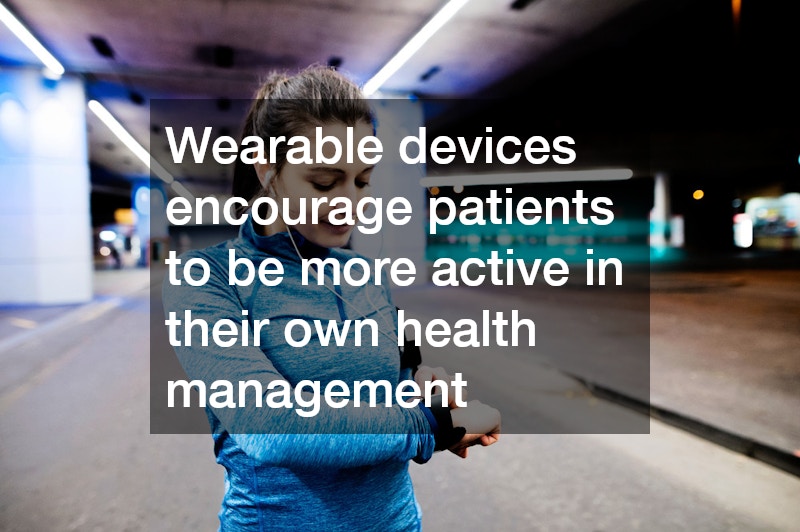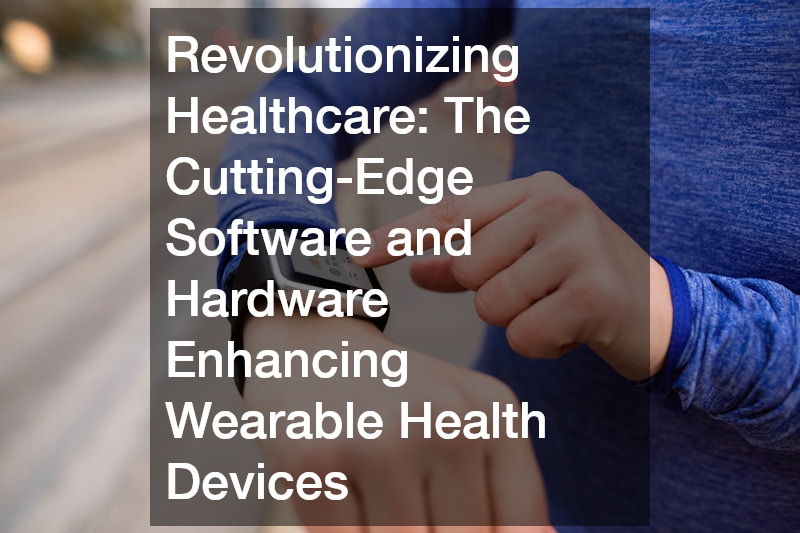Wearable health monitors have become an essential part of modern healthcare. They enable continuous monitoring of health metrics, and offer unprecedented convenience for managing chronic conditions. These devices are now indispensable in patient care due to the convergence of advanced hardware and software. This article examines the latest technological advances in hardware and software that enhance the performance of wearable devices in healthcare and discusses their benefits.
Innovative Software Enhancements for Wearable Devices

Wearable health monitoring devices are only as good as the software behind them. This is because it controls data collection, transmission, and analysis. Recent advances in artificial intelligence, machine learning (ML), data analytics, and other technologies have revolutionized the way healthcare professionals use and process health data.
1. Artificial Intelligence and Machine Learning
AI and ML are now essential components for the development of modern health wearables. Wearable devices can analyze huge amounts of data and identify patterns in real time. Wearable heart monitors, for example, can detect and predict arrhythmia or irregular heartbeats.
Wearable devices can also personalize health advice using machine learning algorithms. Wearables that analyze individual patient data can make tailored lifestyle recommendations and adjust medication or alert healthcare professionals when intervention is needed.
2. Seamless EHR Integration
Integrating wearable devices with EHR systems is a key to improving their reliability. Wearable health monitoring systems can communicate seamlessly with the healthcare provider’s system using modern software. This ensures that the data is stored and accessible during clinical visits. This integration gives clinicians a complete picture of the patient’s condition, allowing them to make more informed decisions.
Wearables integrated with EHRs allow remote monitoring. Healthcare professionals can monitor patient data without having to visit the patient in person. This feature has been particularly useful for managing chronic diseases such as diabetes and hypertension.
3. Prioritizing Data Security and Privacy
The use of wearable health devices is increasing, and so are concerns about data security and privacy. Modern software systems come with encryption technology to protect sensitive health data transmitted from wearable devices into healthcare databases. These devices are often compliant with industry standards, such as HIPAA, the Health Insurance Portability and Accountability Act (HIPAA), which ensures that patient data is secure.
Modern health wearables give users greater control over their data. They can grant or revoke healthcare providers’ access as required. Patients are more likely to use wearables for continuous monitoring of their health because they place a greater emphasis on privacy and security.
Breakthrough Hardware Developments in Wearable Devices
Hardware innovations are just as important as software in driving the evolution of wearable devices for health monitoring. Wearable technology is being pushed to its limits by new sensors, power systems and materials.
Next-Gen Sensor Technology
Sensor quality is a major factor in determining the accuracy of wearable devices that monitor health. Recent advances in sensor technology have increased the precision of these devices’ ability to measure health metrics such as heart rate, blood-pressure, oxygen saturation and glucose levels.
Photoplethysmography sensors (PPG), which are commonly found in fitness trackers and smartwatches, have been improved to be able to measure heart rates under various conditions, including during sleep or exercise. Continuous glucose monitoring (CGM), used to manage diabetes, has become more accurate, giving patients real-time insight into their blood sugar levels.
In addition to these biosensors, wearable devices are being developed that track biochemical markers such as stress hormones or hydration levels. This will expand the options for patient care.
Enhanced Battery Life and Energy Efficiency
The battery life of wearables can also be a critical factor in improving their reliability. Patients rely on the devices to provide continuous monitoring. Modern wearables use energy-efficient processors and sensors, which allow them to operate for longer periods of time without frequent charging.
Researchers are looking at alternative sources of power, including solar and kinetic, in order to increase usability. Health wearables can remain active longer, ensuring uninterrupted patient monitoring.
Innovative Materials and Design for Comfort
Health wearables are also undergoing significant changes in terms of design and materials. Wearable devices today are made of flexible, durable and skin-friendly materials, which ensure comfort even after prolonged use. These devices can be worn anywhere on the body without irritation or discomfort.
Wearables have been designed to be more resistant to environmental factors, such as dust, water, and temperature fluctuations. Waterproof fitness trackers, for example, allow users to monitor their health metrics while swimming or doing high-intensity exercises. Wearables are more reliable and versatile with these hardware innovations.
Key Advantages of Wearable Technology in Healthcare

Wearable technology has many benefits in healthcare, from better patient outcomes to savings for healthcare providers. Here are some key benefits of incorporating wearable technology into patient care.
- Real-Time Health Monitoring: Wearables monitor vital signs and health metrics in real time, allowing early detection and prompt intervention of potential health problems.
- Tailored Healthcare Solutions: Health wearables that collect continuous data can customize treatment plans and make recommendations for each patient based on their individual needs. This ensures more personalized and effective healthcare.
- Enhanced Patient Involvement: Wearable devices encourage patients to be more active in their own health management. These devices provide immediate feedback on exercise, sleep, and medication compliance, motivating patients towards a healthy lifestyle.
- Decreased Hospital Readmissions: Wearables that allow remote monitoring can reduce the frequency of hospital visits. Patients with chronic illnesses can be monitored at home, reducing the risk of readmissions. This also reduces the strain on the healthcare system.
- Cost Savings: Wearable devices are a great way to save money for patients and providers alike. They can help detect problems early and reduce the need for hospitalization. Early intervention can reduce complications and the need for expensive emergency treatment or surgery.
The best medical wearables on the market
Wearables are a popular choice in the market today because of their accuracy, reliability, and usefulness for healthcare. Here is a list of some of the most useful medical wearables available today:
- Apple Watch Series 8: With its advanced heart monitoring features and ECG capabilities the Apple Watch is one of the most reliable devices to track your health.
- Fitbit Sense: This device is a great tool for tracking overall health and wellness. It offers advanced stress monitoring, sleep monitoring, SpO2 measurements, and more.
- Dexcom G6: This continuous glucose monitor is a top choice for diabetics. It provides real-time data on glucose levels and can be integrated with smartphones to alert the user of any significant changes.
- Garmin Venu 2: The Garmin Venu 2 has a reputation for tracking vital signs accurately during workouts. It is a great option for fitness lovers and those who are managing their cardiovascular health.
- Withings ScanWatch: This device is a great choice for long-term monitoring of health. It combines traditional watch design and medical-grade heart monitoring including ECG tracking and oxygen saturation monitoring.
In summary, wearable health monitors are revolutionizing modern healthcare by providing continuous health metric monitoring and enhancing the management of chronic conditions. The integration of advanced hardware and innovative software, including artificial intelligence and seamless EHR connectivity, empowers patients to take an active role in their health while ensuring healthcare providers have comprehensive data for informed decision-making. With breakthroughs in sensor technology, improved battery life, and user-friendly designs, these devices not only promote better health outcomes but also reduce hospital readmissions and costs. As the market for wearables grows, products like the Apple Watch Series 8 and Fitbit Sense exemplify the potential of this technology to create a more proactive and personalized healthcare experience.


Leave a Reply